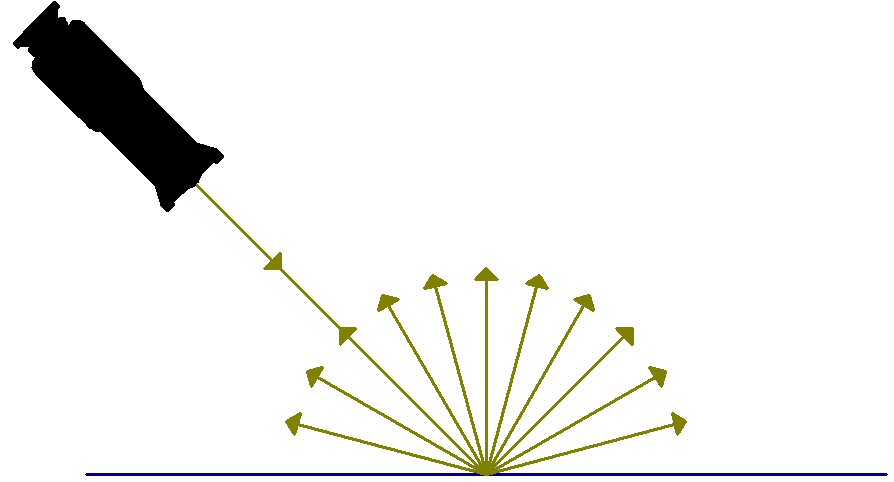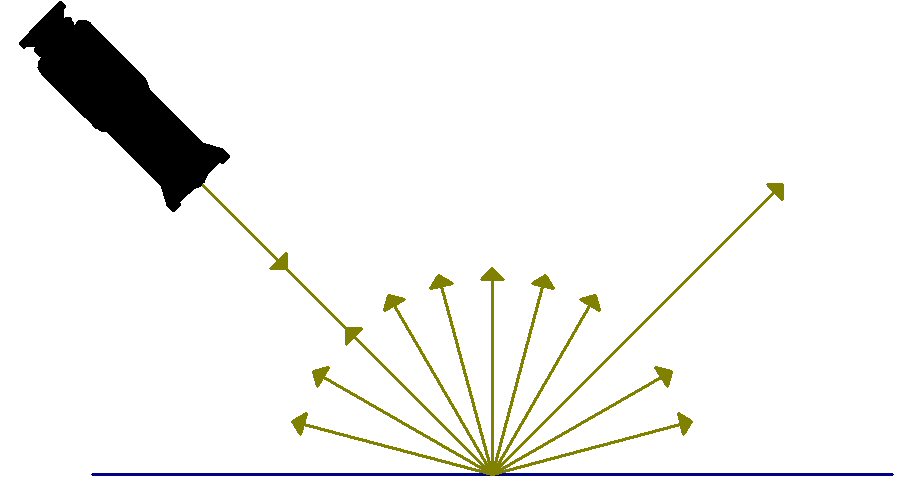|
The Law of Reflection:
|
"The angle of reflection is equal to the angle of incidence."
|
|
Terminology:
|
The reflector is a mirror (usually curved) in the back of a lighting
fixture, which redirects back through the front of the fixture
those rays of light which hit it.
To understand how stage lighting fixtures work, you must first
understand how reflectors work. To understand how reflectors
work, you first must understand how reflection works.
. . .And to understand how reflection works, you must understand
the following terms:
|
The Normal
|
The line perpendicular to the surface at the point of reflection.
If we are working with a curved reflector, the normal is a line
perpendicular to a tangent to a curve at the point of reflection.
|
|
|
|
The Angle of Incidence
|
The angle between the normal and the beam of light as it hits
the point of reflection.
|
|
|
|
The Angle of Reflection
|
The angle between the normal and the reflected beam of light.
|
|
|
One non-lighting example of the law of reflection is the bank shot in pool.
|
|
Types of Reflection:
|
There are four types of reflection:
- Specular Reflection changes
the direction of a beam of light without otherwise appreciably
altering the nature of beam. A mirror is a specular reflector.

- Diffuse Reflection occurs
when the beam of light is completely dispersed. The light
bounces off the reflector in all directions. Example: flat paint.

- Spread Reflection is similar
to diffuse reflection, except that a greater percentage of
the light is reflected along the angle of reflection than
along any other line. Example: crumpled-up
aluminum foil.

- Mixed Reflection is a mixture
of diffuse and specular reflections. Examples:
a doorknob / shiny wood floor /gold watch

|
|
Reflectors
|
Why do we use reflectors in stage lights? Because if we didn't,
the only light we'd get out of a stage lighting fixture would
be the light radiated from the lamp in the direction of the stage.
Since our goal is to achieve the highest level of efficiency,
reflectors enable us to capture and use light beams which would
otherwise be lost.
Stage lighting fixtures use several types of reflectors. Almost
all use specular reflection. These are the most common:
|
Ellipsoidal Reflector
|
An ellipse is "a closed curve, generated by a point moving in
such a way that the sum of its distances from two fixed
points is constant." An ellipsoid is a
3-dimensional ellipse. An ellipsoidal reflector has two
focal points; light rays originating at one focal point
converge at the other. An ellipsoidal reflector is actually
½ of an ellipsoid.

|
|
Spherical Reflector
|
Spherical reflectors reflect all beams which strike
the reflector from or through the center of curvature back
through the center of curvature. This is indicated by the
red lines and arrows in the drawing below.
The focal point is at 1/2 the radius of the sphere. As
with parabolic reflectors (see the section below), any beam
that passes through the focal point and strikes the mirror
will be reflected out in parallel rays. This is indicated
by the amber lines and arrows in the drawing below.
[Special thanks to Bill Nelson.]

|
|
Parabolic Reflector
|
Parabolic reflectors reflect all beams which strike the reflector
from or through the focal point out parallel to each other
in a beam of light approximately the diameter of the
reflector. Example: searchlights, many hand-held flashlights/torches.

|
|
|